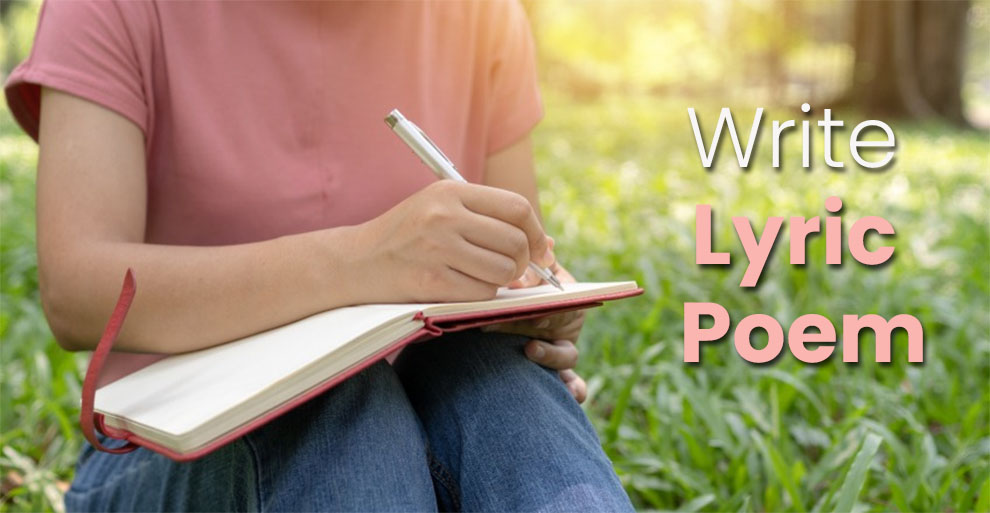We all have a poet inside us but most of us have no idea how to give a form to our thoughts and feelings. If you are curious to explore the poet in you but don’t know where to start, we can help you out.
Lyric poetry, which deals with themes of personal feelings and emotions, is a great option for you. But before you get down to writing, there are a few things you need to be aware of. Here’s all you need to know about how do you write a lyric poem.
Jump To
- What Is Lyric Poem Writing?
- History of Lyric Poetry
- Characteristics of A Lyric Poem
- Common Meters Used In Lyric Poem Writing
- How To Write a Lyric Poem Step by Step?
- Tips To Help You Write A Lyric Poem
- Different Types of Lyric Poems
- Conclusion
What Is Lyric Poem Writing?
To put it simply, a lyric poem can be defined as a short poem, marked by songlike qualities, which focuses on the personal emotions of the speaker.
Historically, a lyric poem was intended to be sung along with musical instruments. In today’s time, it has come to represent non-narrative poetry like odes, sonnets, and elegies.
History of Lyric Poetry
To understand what Lyric poetry is and how to make a lyric poem better, you need to learn more about its history and origins.
Lyric poetry has its root in Ancient Greece where it originated as a song, usually accompanied by the lyre. In fact, it derives its name from the lyre. But the lyric was at times sung with other instruments or recited without one.
Lyric poetry was divided into two categories-choral lyric and monody. While choral lyric was performed by a chorus generally in public at religious ceremonies, monody was a solo that was usually limited to private gatherings.
Unlike other forms of poetry that were popular at that time (dramas written in verse, epic poems, etc), the lyric was notably shorter and focused on personal themes and the state of mind of the poet.
Traditionally, lyric poem writing follows strict formal rules. However, over centuries various types of lyric poetry emerged. This is why today’s lyric poetry has several different forms.
Characteristics of A Lyric Poem
Before you learn how to write a lyric poem, you need to understand its features. A poem is considered to be a lyric poem if it possesses the following qualities:
- It is musical. However, this may not always be the case.
- It is written in first-person narrative.
- It expresses the personal emotions or state of mind of the poet.
- It is not a narrative and does not tell a story. It deals with personal themes like rage, love, despair, anger, etc.
- It follows a formal structure that decides its meter, verse form, and rhyme scheme. However, when it comes to meter, lyric poets have a lot of variety to choose from.
Common Meters Used In Lyric Poem Writing
Meter is the rhythmic structure of a line in a poem and consists of a number of syllables and the pattern of stress in them. Here are a few common meters used in lyric poetry.
- Iambic meter: Iambic is a 2-syllable ‘foot’ where the stress is on the second syllable. Iambic pentameter (where each line has 5 iambs) is the most common lyric form found in English lyric poems.
- Trochaic meter: This is the inverse form of the iambic meter. Every trochee (trochaic foot) has a long (stressed) syllable followed by a short (unstressed) one. Every line has 4 trochaic feet in trochaic tetrameter.
- Phyrric meter: Phyrric meter features 2 unstressed syllables or dibrach. It appears when the rhythm of a poem’s line consists of two short syllables followed by longer ones. It is not enough to construct a whole poem on its own.
- Anapestic meter: In an anapest, 2 short (unstressed) syllables are followed by a long (stressed) syllable. The history of lyric poetry is full of examples of a poem written in this meter.
- Dactylic meter: The inverse of an anapest, a dactyl is a long (stressed) syllable followed by 2 short (unstressed) ones.
- Spondee meter: In a spondaic foot, there are 2 long (stressed) syllables. For creating variation in lyric poetry, the Spondaic meter is interspersed with other types of verse.
How To Write a Lyric Poem?
Whether you have been trying your hand at poetry for some time or you are absolutely new to the whole thing, this form of poetry can be your jam! To make it easier for you, we have simplified the process of how to make a lyric poem into a few easy steps.
Step 1: Do the research work
The first and most important foundational step is research. Before you get down to penning your thoughts on a paper in form of a lyric poem, you require a little preparation:
- Check out the works of poets like P B Shelley, Emily Dickinson and Alfred Lord Tennyson and others who are credited with creating timeless pieces of lyric poetry. This will give you the much-needed inspiration you need on how do you write a lyric poem and put your thoughts into words.
When doing the research work for lyric poem writing, read poems that belong to the genre you intend to write in. - Do your homework to make sure you have a good understanding of poetic devices like meter, rhythm, rhyme scheme, alliteration, etc.
- Do a little research on the various forms of lyric poetry. This will help you decide which type of lyric poetry you want to write. It can be a sonnet, an ode, an elegy of any other form that offers what you need to put your feelings into words in the best way.
Step 2: Moving on to prep-work
The next step in how to write a lyric poem step by step is prep work. Now that you have got the research part covered, it’s time to move a step closer to writing your lyric poem.
- When lyric poem writing, pick a topic that moves you and resonates with your thoughts and emotions. Writing becomes so much easier when we write something we are passionate about.
- Start writing down your thoughts and feelings. This will give you a much-needed sense of clarity and make it easier for you to shape your words into a masterful lyric poem. You must be aware of your senses and feelings.
Step 3: Start writing your poem
- Here’s the last step in the process of how to make a lyric poem. Once you get a clear idea of the feelings, emotions, and words that radiate within you, it is time to put down those words in form of a lyric poem. Use everything you learned during your research to create a beautiful lyric poem.
Tips To Help You Write A Lyric Poem
Now that you know how to write a lyric poem step by step, here are a few additional tips and tricks that you need to keep in mind:
- We live in a time when learning has become so much easier, thanks to online learning platforms. Go for an online poetry course if you think you need some help and guidance to learn how to make a lyric poem more interesting.
- Make sure you stay true to what you are actually feeling. For instance, if you are writing about love, make sure you pen down exactly how love makes you feel and how you interpret things when you are in that state of mind.
- Literary devices can help beautify your work but nothing beats the depth and honesty of your true emotions.
- Seek the help of a thesaurus if you are having difficulty coming up with the right words.
- Every thought and feeling you express in your poem should feel connected. Your transition from one stanza to another should be smooth.
- While it is okay to draw inspiration from other poets, make sure you don’t lose your original voice.
- Since we are talking about lyric poem writing, make sure there is a musical touch in your poem.
- Make sure your poem has all the elements of a lyric poem.
- Most poets and writers are not that happy with their first draft. The key is to keep trying until you have nailed it down to perfection. Also, it will help to take advice and feedback from people you trust or someone who knows this form of poetry well.
How Do You Write A Lyric Poem of Different Types?
So now you know how to make a lyric poem. But do you know which type of lyric poem you want to write? In order to decide that, you need to know about a few common forms of lyric poetry:
- Ode: This is perhaps one of the earliest forms of lyrical poetry which first formally appeared with the Greeks. Odes are often marked by varied and elaborate structures and usually focus on celebrating or praising a person, an idea or a place.
Example: Here are the first 3 parts of Ode To The West Wind by Percy Bysshe Shelley
I
Thou, from whose unseen presence the leaves dead
Are driven, like ghosts from an enchanter fleeing,
Yellow, and black, and pale, and hectic red,
Pestilence-stricken multitudes: O thou,
Who chariotest to their dark wintry bed
The winged seeds, where they lie cold and low,
Each like a corpse within its grave, until
Thine azure sister of the Spring shall blow
Her clarion o’er the dreaming earth, and fill
(Driving sweet buds like flocks to feed in air)
With living hues and odours plain and hill:
Wild Spirit, which art moving everywhere;
Destroyer and preserver; hear, oh hear!
II
Loose clouds like earth’s decaying leaves are shed,
Shook from the tangled boughs of Heaven and Ocean,
Angels of rain and lightning: there are spread
On the blue surface of thine aëry surge,
Like the bright hair uplifted from the head
Of some fierce Maenad, even from the dim verge
Of the horizon to the zenith’s height,
The locks of the approaching storm. Thou dirge
Of the dying year, to which this closing night
Will be the dome of a vast sepulchre,
Vaulted with all thy congregated might
Of vapours, from whose solid atmosphere
Black rain, and fire, and hail will burst: oh hear!
III
The blue Mediterranean, where he lay,
Lull’d by the coil of his crystalline streams,
Beside a pumice isle in Baiae’s bay,
And saw in sleep old palaces and towers
Quivering within the wave’s intenser day,
All overgrown with azure moss and flowers
So sweet, the sense faints picturing them! Thou
For whose path the Atlantic’s level powers
Cleave themselves into chasms, while far below
The sea-blooms and the oozy woods which wear
The sapless foliage of the ocean, know
Thy voice, and suddenly grow gray with fear,
And tremble and despoil themselves: oh hear!
- Ballad: This form of lyric poem writing is mainly associated with England (late Middle Ages to the 19th century). These narrative poems are usually set in 4 line-stanzas (but not always) featuring a repeating refrain.
Example: Here are a few lines from The Ballad of Reading Gaol by Oscar Wilde
By all let this be heard,
Some do it with a bitter look,
Some with a flattering word,
The coward does it with a kiss,
The brave man with a sword!
- Sonnets: Traditionally, the origin of sonnets is believed to have its roots in Sicily (Italy). This form of lyrical poetry consists of a 14-lined single stanza. The initial lines of the poem set a situation whereas the concluding lines feature a response or a shift. It has 3 forms-Petrarchan, Spenserian and Shakespearean.
You miss out on a lot if you do not know how to write a lyric poem that’s a sonnet.
Example: That Time Of Year Thou Mayest In Me Behold by William Shakespeare
When yellow leaves, or none, or few, do hang
Upon those boughs which shake against the cold,
Bare ruin’d choirs, where late the sweet birds sang.
In me thou see’st the twilight of such day
As after sunset fadeth in the west,
Which by and by black night doth take away,
Death’s second self, that seals up all in rest.
In me thou see’st the glowing of such fire
That on the ashes of his youth doth lie,
As the death-bed whereon it must expire,
Consum’d with that which it was nourish’d by.
This thou perceiv’st, which makes thy love more strong,
To love that well which thou must leave ere long.
- Elegy: This form of lyric poem writing is marked by darker emotions and feelings like melancholy, mourning, and contemplation. These usually commemorate the dead and lost. Originally, elegies featured a strict structure consisting of meter alternating between 6 foot and 5 foot lines. However, modern elegies do not follow a specific format.
Example: In Memory Of WB Yeats by W H Auden
I
The brooks were frozen, the airports almost deserted,
And snow disfigured the public statues;
The mercury sank in the mouth of the dying day.
What instruments we have agree
The day of his death was a dark cold day.
Far from his illness
The wolves ran on through the evergreen forests,
The peasant river was untempted by the fashionable quays;
By mourning tongues
The death of the poet was kept from his poems.
But for him it was his last afternoon as himself,
An afternoon of nurses and rumours;
The provinces of his body revolted,
The squares of his mind were empty,
Silence invaded the suburbs,
The current of his feeling failed; he became his admirers.
Now he is scattered among a hundred cities
And wholly given over to unfamiliar affections,
To find his happiness in another kind of wood
And be punished under a foreign code of conscience.
The words of a dead man
Are modified in the guts of the living.
But in the importance and noise of to-morrow
When the brokers are roaring like beasts on the floor of the bourse,
And the poor have the sufferings to which they are fairly accustomed
And each in the cell of himself is almost convinced of his freedom
A few thousand will think of this day
As one thinks of a day when one did something slightly unusual.
What instruments we have agree
The day of his death was a dark cold day.
II
The parish of rich women, physical decay,
Yourself. Mad Ireland hurt you into poetry.
Now Ireland has her madness and her weather still,
For poetry makes nothing happen: it survives
In the valley of its making where executives
Would never want to tamper, flows on south
From ranches of isolation and the busy griefs,
Raw towns that we believe and die in; it survives,
A way of happening, a mouth.
III
William Yeats is laid to rest.
Let the Irish vessel lie
Emptied of its poetry.
In the nightmare of the dark
All the dogs of Europe bark,
And the living nations wait,
Each sequestered in its hate;
Intellectual disgrace
Stares from every human face,
And the seas of pity lie
Locked and frozen in each eye.
Follow, poet, follow right
To the bottom of the night,
With your unconstraining voice
Still persuade us to rejoice;
With the farming of a verse
Make a vineyard of the curse,
Sing of human unsuccess
In a rapture of distress;
In the deserts of the heart
Let the healing fountain start,
In the prison of his days
Teach the free man how to praise.
Related: Online Latin Language Courses, Phonics Training Online,How to Write An Academic Book Review?
Conclusion
Lyric poetry is one of the most rewarding ways to give shape and form to your emotions.
To create a beautiful piece and learn how to write a lyric poem, it is vital to know the form well, select a genre you connect with and stay true to your emotions.
The most important part of how do you write a lyric poem is persistence. It may take a while but with practice and determination, you can master this art and become a lyric poet! All the best.





